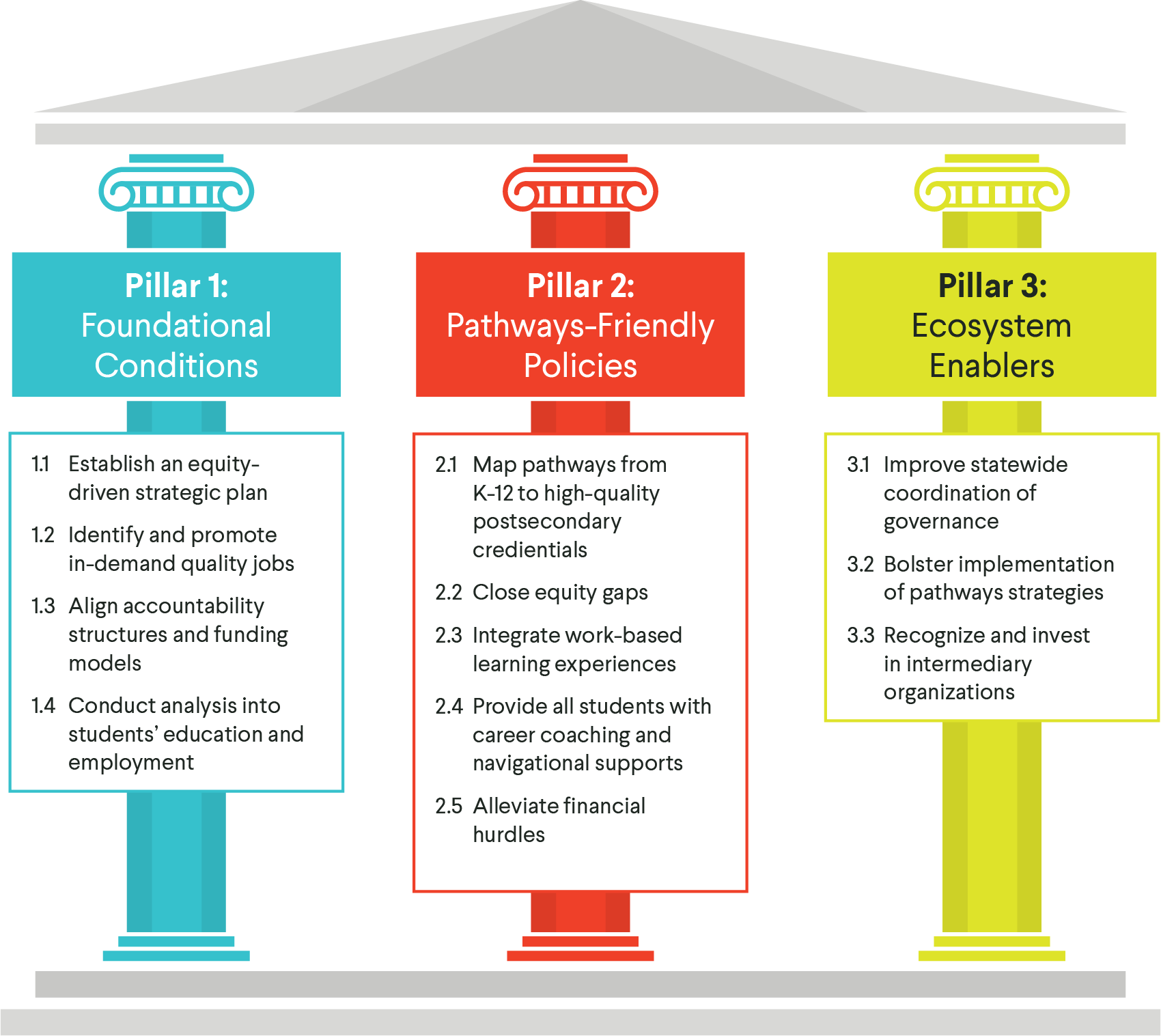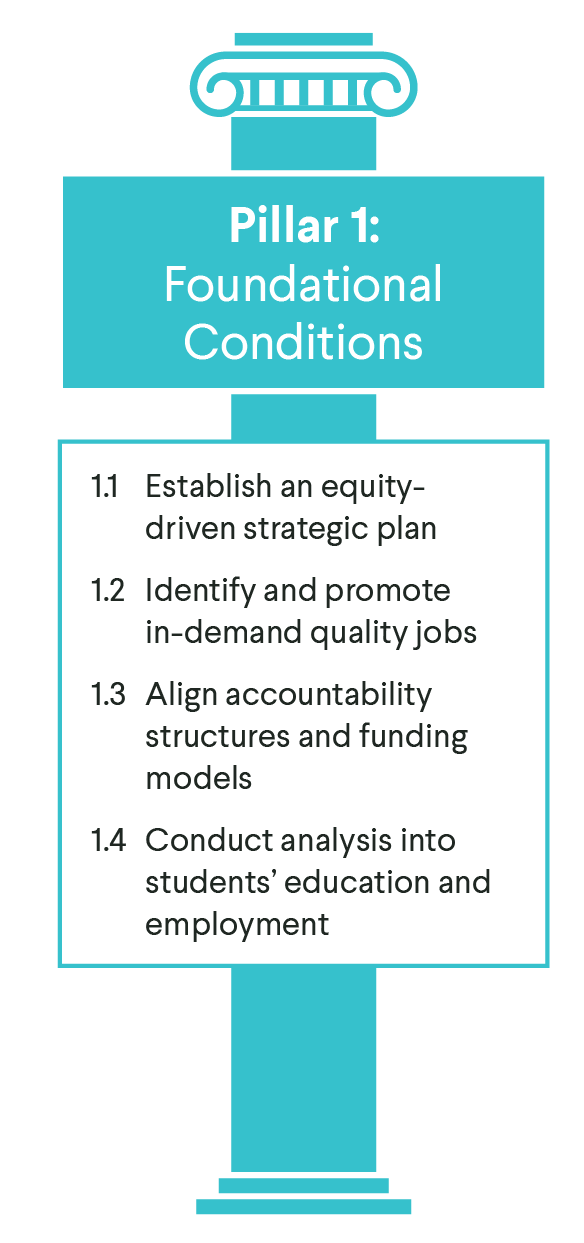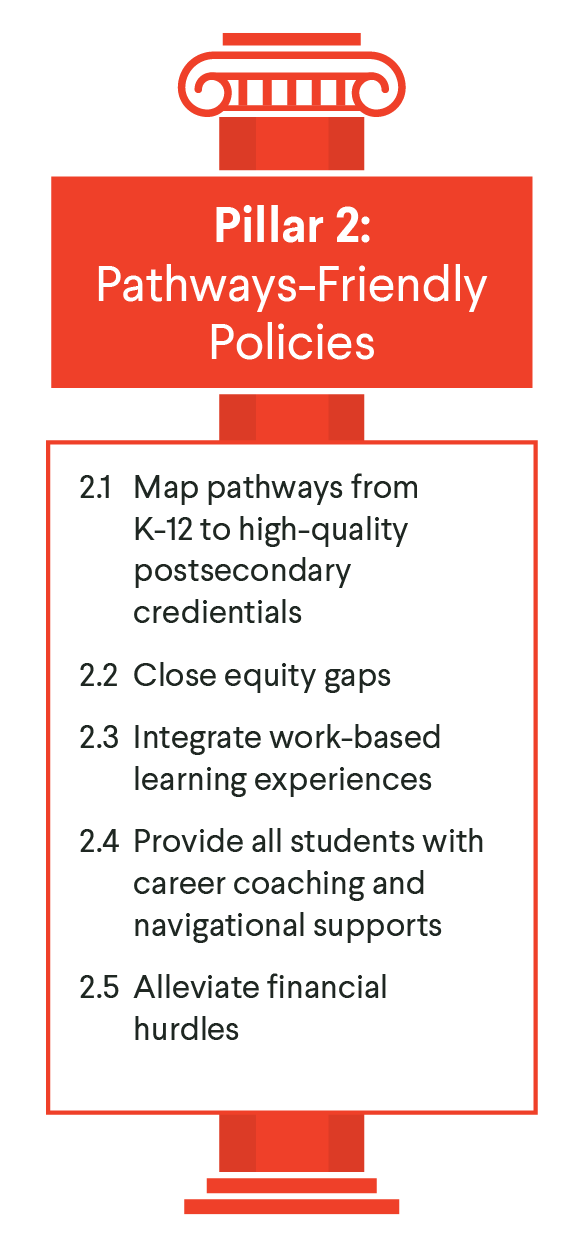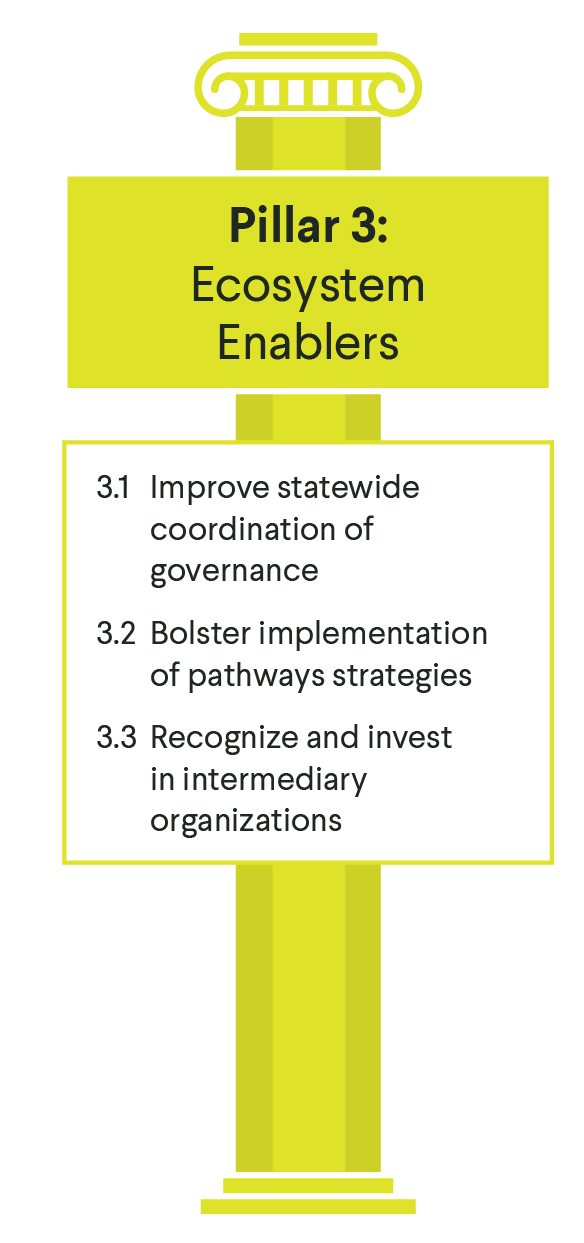State Policy Framework
Strengthening College and Career Pathways Systems Through Guiding Policy and Advocacy Efforts
Today’s youth face an uncertain economic future. Disruptions to their schooling and the labor market are prompting young adults to wonder where they fit within the nation’s rapidly changing social and economic picture, and what paths lead forward.
It will take intentional policy action to close gaps in opportunity in education and employment. Without bold policy and programmatic action, the outlook will be particularly troubling for Black and Latinx youth and young people experiencing poverty because the pandemic exacerbated longstanding educational and economic disparities.
Jobs for the Future (JFF) designed the State Policy Framework for Building Equitable Pathways to inform state policymakers and advocates on how policy can disrupt educational achievement gaps and occupational segregation while realizing the vision of discoverable and durable pathways to upward economic mobility.
We encourage states to use the BEP Policy Assessment Tool as a companion piece to this framework to review existing and proposed policies of their state’s legislative and governing entities to determine the extent to which their state policy environment aligns to the framework and, thus, provides conducive conditions for building equitable pathways.
About the Building Equitable Pathways Community of Practice
JFF developed this framework with input from our Building Equitable Pathways (BEP) Community of Practice, a group of 14 innovative intermediary organizations uniquely well-positioned in their communities to strengthen college and career pathways systems and inform the development of equitable policy conditions. The framework is intended to guide the policy and advocacy efforts of BEP members, as well as those efforts by the broader ecosystem of intermediaries and policy actors concerned about equitable educational and economic opportunities for today’s youth.
Three Pillars for State Policy Action
The State Policy Framework for Building Equitable Pathways covers 12 key state policy issues—from data systems to dual enrollment to regional capacity—that are essential to strengthening pathways and closing equity gaps. The issue areas are organized into three overarching pillars and highlight a mix of levers for policy change. State, local, and systems policy change across all three pillars is necessary to support Black, Latinx, and Indigenous youth and close equity gaps.
Every state has more work to do to enhance and center equity across each state policy issue area highlighted in this framework. However, to exemplify how states can affect meaningful improvements, JFF has curated a list of examples of states progressing on each policy issue area.
The three pillars for state policy action:

Pillar 1: Foundational Conditions
Foundational Conditions for Uncovering and Disrupting Educational Achievement Gaps and Occupational Segregation
States need to understand the structural and systemic barriers that disproportionately harm the education and employment prospects of Black, Latinx, and Indigenous youth and then set measurable goals and accountability mechanisms for closing gaps and improving outcomes. Building a strong statewide infrastructure is key to informing and incentivizing collective action toward improving equitable outcomes across the pathways ecosystems.

-
1.1
Establish an equity-driven strategic plan endorsed by education and workforce agencies that name racial equity as a top policy and performance priority for state agencies and the governor.
Through the plan, states should set measurable goals for improving equitable outcomes in secondary and postsecondary education and training, especially related to high-demand, high-wage occupations and industries. States should name key research questions for identifying critical barriers to college and career success and advancement for Black and Latinx populations. States also should emphasize cross-agency alignment on equitable pathways and serve as a launching pad for developing and funding evidence-based, race-conscious initiatives.
Examples of progress include:
- Massachusetts
- The Department of Higher Education's Equity Agenda is Massachusetts’ statewide strategic plan focused on equity, which includes specific targets for those historically underserved and underrepresented, especially students of color, throughout all levels of education.
- Texas
- Building a Strong Texas is Texas’ strategic plan for higher education that focuses on setting targets for increasing postsecondary credentials and credentials of value.
- Virginia
- Opportunity 2027 is Virginia’s 2021-2027 strategic plan with five goals for community colleges to achieve equity in students learning outcomes. This includes a dashboard report with information on race, gender, and socioeconomic groups.
- Massachusetts
-
1.2
Identify and promote in-demand quality jobs, the pathways for attaining these jobs and advancing up a career ladder, and the characteristics of workers in these positions, in order to discover and address areas of occupational segregation.
States should develop a common methodology across education, workforce, and economic development agencies for defining and promoting quality, in-demand jobs and more consistent models for mapping pathways and for identifying skill gaps. This will require modernization of labor market information to incorporate sources of real-time intelligence and employment data; user-friendly publicly accessible interface for examining regional and statewide demand for occupations, industries, and skillsets; and a commitment to analyze and publicly reports data on workforce characteristics to increase transparency on racial patterns in high-growth, high-wage industries and occupations.
Examples of progress include:
- Colorado
- Talent Pipeline Report is the Colorado Workforce Development Council’s report analyzing annual, relevant labor market data and providing recommendations to enhance the talent pipeline in Colorado. This report is published annually in accordance with 24-46.3-103 C.R.S. as amended by SB14-205 and developed in partnership with state partners.
- Delaware
- The state’s combined plan for Workforce Innovation and Opportunities Act (WIOA) and the Strengthening Career and Technical Education for the 21st Century Act (Perkins Act) aligns approaches taken by labor and education agencies for identifying high-demand, high-wage occupations.
- Indiana
- Hoosiers by the Numbers provides labor market information by region or topic in Indiana, including highlights across 92 counties of critical population and workforce statistics.
- Colorado
-
1.3
Align accountability structures and funding models that bolster equitable pathways.
States should develop infrastructure and a common, agreed-upon methodology among education and workforce agencies for vetting postsecondary credentials against quality standards (e.g., validating the extent credentials are stackable, portable, and aligned to careers that provide economic security and upward mobility) and publicly report vetted credentials in a database. Additionally, states should establish standards for career readiness as part of high school graduation requirements. And, through financial and accountability incentives, states should encourage and reward education institutions for awarding quality credentials and for students meeting career readiness, including through weighted incentives for student populations historically marginalized and underserved by education systems.
Examples of progress include:
- Alabama
- Success Plus is Alabama’s program for improving postsecondary education levels, setting targets for earning certificates, credentials, and degrees of value.
- Florida
- HB1507 facilitates a cross-sector approach to defining and identifying credentials of value and creates the Money-Back Guarantee Program, requiring each school district and Florida College System school to refund the cost of tuition to students who are not able to find a job within six months of completing select programs.
- Tennessee
- Ready Graduate Indicator is an accountability metric in Tennessee’s Every Student Succeeds Act aligned to the Tennessee Department of Education’s strategic plan. The indicator measures the percentage of students who earn a diploma from a Tennessee high school and meet success milestones (e.g., dual enrollment, early credits, certifications) that increase their probability of seamlessly enrolling in postsecondary education.
- Texas
- Texas’ House Bill 3, passed in 2019, sets standards for college-, career-, or military-ready outcomes funding.
- Virginia
- FastForward is Virginia’s credentialing program targeting working adults through providing a “pay-for-performance” model incentivizing funding of noncredit workforce training for industry-recognized credentials, validated by the state workforce development system.
- Alabama
-
1.4
Routinely conduct analysis into students’ education and employment outcomes disaggregated by race, gender, socioeconomic, and geographic level and make findings publicly available.
States should establish and maintain a statewide longitudinal data system, governed by a neutral third party, that links individual student records across public K-12 schools, higher education, workforce development, human services, and employment. States should provide the infrastructure and resources needed to conduct ongoing analysis of student education and employment outcomes to identify key equity gaps to college and career success, especially in high-demand and high-wage fields. States also should routinely and publicly release findings to guide continuous improvement efforts by institutions, inform policymaking discussions, and guide decisions by students and their families.
Some states have already started these initiatives, such as:
- California
- Cradle-to-Career System is the statewide longitudinal data system for California based on legislation passed in 2019 linking existing education, workforce, financial aid, and social service information for all students throughout the state. This includes data sets not only for researchers, policymakers, and educators but also planning and application tools for students and families.
- Maryland
- Baltimore Youth Data Hub is Baltimore City’s system linking data across multiple youth-serving organizations, including public agencies and nonprofits, to share data as a central archive and assess program effectiveness.
- Washington
- Education Research & Data Center links Washington’s education and workforce data across multiple state agencies to provide cross-sector research.
- California
Learn more about foundational conditions and the examples listed by downloading the PDF.
Pillar 2: Pathways-Friendly Policies
Pathways-Friendly Policies for Advancing Equitable Outcomes
States need education and employment systems that lead to equitable access and success at every stage and transition point along college and career pathways through attainment of a postsecondary credential of value and entry into a career-launching job. Doing so will enable all youth to obtain the knowledge, skills, supports, and relationships they need to advance in today’s economy. Policy levers include greater alignment of secondary and postsecondary curricula and programs of study, integration of high-quality work-based learning experiences, robust support to navigate choices related to college and career, and proactive wraparound supports to alleviate financial barriers.

-
2.1
Map pathways from K-12 to attainment of high-quality postsecondary credentials that launch students into high-demand, high-wage careers.
States must ensure these pathways clearly define recommended course sequences across high school and college to save time and money toward attaining one or more postsecondary credentials of value. The pathways should be endorsed across systems; discoverable and transparent to guide decisions for all students and their families; and permeable, durable, and stackable to avoid pathways that limit options and create dead ends.
Examples of progress include:
- Illinois
- The Postsecondary & Workforce Readiness Act (PWR), signed into Illinois law in 2016, takes a student- and competency-based approach in its college and career pathway endorsement framework. In addition, Illinois’ Essential Employability Skills Framework and Self-Assessment defines essential employability skills and provides statewide standards for success to align education and workforce needs. The Illinois Model Programs of Study Guides provide information on the labor market, credential programs, and secondary, postsecondary, and employer stakeholders on specific career pathways.
- Indiana
- Next Level Programs of Study is Indiana’s redesign of all career and technical education programs of study in a pathways guide for parents, students, school counselors, and teachers.
- Tennessee
- Tennessee Pathways recognizes and rewards high schools meeting minimum requirements set by the state that support pathways to increase alignment between K-12, postsecondary education, and employers.
- Illinois
-
2.2
Close equity gaps in dual and concurrent enrollment so all students may benefit from early college experiences.
States should set a statewide public goal for increasing participation and success of traditionally underserved student groups, including Black, Latinx, and youth experiencing poverty, English learners, students with disabilities, foster youth, young people experiencing homelessness. States should follow through with this equity goal by: (a) ensuring all dual and concurrent enrollment course offerings align to and accelerate students’ pathways to postsecondary credentials valued in the labor market; (b) allocating resources to make sure all students can access college in school programs regardless of geography or their ability to pay for out-of-pocket expenses for tuition, books, fees, and transportation; (c) requiring multiple measures, beyond high-stakes testing, to establish student readiness for college-level courses; and (d) providing students with gaps in college readiness with evidence-based developmental education opportunities, such as corequisite remediation and transitional courses, to accelerate their preparation for college.
Examples of progress include:
- California
- AB 705 is a bill going into effect in 2018 clarifying multiple measures and acceleration approaches requiring community college or college to maximize the probability a student will enter and complete transfer-level coursework.
- Colorado
- Accelerating Students through Concurrent Enrollment (ASCENT) is Colorado’s policy and state adoption of permanent funding to scale programs. ASCENT provides an accelerated opportunity for students to earn a postsecondary credential.
- Illinois
- The Dual Credit Quality Act in Illinois includes a model partnership agreement that incentivizes equitable access and strategic early college credit. In addition, see the Postsecondary & Workforce Readiness Act (PWR) and Illinois’ Essential Employability Skills Framework and Self-Assessment incentivizing strategic dual credit.
- Indiana
- The Indiana College Core and High School-based Dual Credit Crosswalk are guidance programs that award credit for prior learning.
- Tennessee
- The Tennessee dual enrollment policy is a lottery scholarship providing grant funding for dual enrollment tuition and fees. In addition, the program ensures credit transferability and awards credit based on a final exam.
- Washington
- HB 1599 is an automatic acceleration policy in Washington providing students with the opportunity to be placed in advanced math, English, and science classes in all high schools to reduce inequities amongst students.
- California
-
2.3
Integrate work-based learning experiences in academic and career-technical courses to prepare for college and careers.
States should set participation goals, desired outcomes, and quality standards for a continuum of developmentally appropriate work-based learning experiences throughout middle and high school and college. They should focus explicitly on boosting participation by student populations historically underrepresented in apprenticeships, internships, and other applied learning and workplace experiences. States should direct resources and technical assistance, such as transportation, uniforms and tools, and subsidies for student wages, to schools and institutions serving a large share of Black and Latinx individuals and those experiencing poverty, alleviating financial barriers to student engagement. States also should incentivize employer partnerships in the design and delivery of work-based learning experiences while creating statewide transparency around the federal Fair Labor Standards Act to make clear that employers may hire youth apprentices while maintaining high safety standards. Finally, states should adjust attendance policies and seat-time requirements to allow for flexibility for counting out of-school learning activities toward required seat time for the award of credit.
Examples of progress include:
- California
- The Learning-Aligned Employment Program offers eligible students at California public colleges and universities the opportunity to earn money to support education costs while gaining education-aligned, career-related employment.
- Colorado
- In SB22-140, Colorado established a work-based learning incentive program.
- Illinois
- The development of statutory definitions and toolkit supports alignment across agencies and initiatives as well as quality implementation for career pathways in Illinois.
- Tennessee
- The Work-Based Learning Implementation Guide and Work-Based Learning Toolbox provides Tennessee districts with resources to build strong, effective work-based learning programs.
- Washington
- The Workforce Education Investment Act in Washington is an investment that creates the Washington College Grant, which increases college accessibility. The grant provides full-tuition scholarships to families making $55,000 or less and a partial scholarship to families making up to 100 percent of the median family income.
- California
-
2.4
Provide all students career coaching and navigational support to strengthen exploration, planning, and a sense of belonging in college and careers.
States should establish the expectation that every student develop and regularly update a career plan before high school graduation; support the professional development of advising personnel in high school, college, and community-based organizations to deliver culturally competent career coaching; and invest in a career navigation technology platform that provides career and education guidance and support customized to unique needs and goals of students and their families, including making information available in multiple languages.
Examples of progress include:
- Colorado
- MyColoradoJourney is Colorado’s unified career navigation system, developed through a memorandum of understanding with the Colorado Workforce Development Council and includes the Colorado Departments of Higher Education, Labor and Employment, and Human Services.
- Illinois
- The Postsecondary and Career Expectations Framework (PaCE) is an organizing tool in Illinois to help acknowledge and connect areas of success. In addition, HR0681 urges the Illinois Student Assistance Commission to publish an annual report documenting districts implementing the PaCE frameworks on their websites.
- Massachusetts
- My Career and Academic Plan (MyCAP) requires schools to create provisional college and career plans for all students to engage in postsecondary planning based on the student’s interests.
- North Carolina
- The Carolina Works study success coaching model aimed to increase student persistence across 10 North Carolina community colleges.
- Texas
- The effective advising framework in Texas is a collaborative statewide effort providing a vision for planning, implementing, and evaluating an advising program to support academic and career development in K-12.
- Colorado
-
2.5
Alleviate financial hurdles to postsecondary entry, persistence, and completion.
States should adopt financial counseling and aid policies that bolster economic security and make transitions to college, postsecondary training, and careers affordable for all students. States should mandate that students complete financial aid applications before high school graduation and provide schools and community-based organizations with resources to ensure they proactively support historically underserved students and their families throughout the financial aid process. States also should ensure state-funded financial aid programs are accessible to all populations (undocumented, homeless, carceral experience); flexible to cover a range of high-quality postsecondary experiences, including short-term training; provide allowances for educational and living expenses, and incentivize completion and transfer. States also should proactively expand students’ access to basic needs (e.g., food, housing, transportation) through reforms to eligibility criteria, outreach, and increased coordination by education and human services agencies. Finally, states should mitigate the negative effects of student debt, including strategies to minimize debt accumulation and forgiving small amounts of unpaid fees to increase students’ persistence toward college completion and their financial stability.
Examples of progress include:
- Arkansas
- The YOUniversal Scholarship System used by Arkansas provides students information on career-related financial aid programs. A single application can determine a student’s eligibility for all state scholarship programs.
- Arkansas and Oregon
- The Building State Career Pathways Systems is a toolkit to help states create career pathways systems that integrate and expand partnerships between state human service agencies and community and technical college systems and institutions so that more people have the opportunity to train for a quality career, illustrating model career pathways frameworks from Arkansas and Oregon.
- Illinois
- The House Bill 4201 requires all public Illinois universities to set up benefits navigator positions on campus to help students access federal, state, and local assistance benefits programs.
- Illinois, Louisiana, and Texas
- These three states have adopted policies linking Free Application for Federal Student Aid (FAFSA) filing and graduation, requiring high school seniors to file the FAFSA before graduation.
- Arkansas
Learn more about pathways-friendly policies and the examples listed by downloading the PDF.
Pillar 3: Ecosystem Enablers
Ecosystem Enablers to Foster Regional Collaboration Toward Racial Equity
States need to foster stronger partnerships among K-12, higher education, business and industry, workforce development, and health and human services at the regional level to develop pathways systems geared toward equitable economic advancement. Policy levers include reforming governance and structures to enable collective action within regions.

-
3.1
Improve statewide coordination of governance.
States should improve statewide coordination of governance across K-12, higher education, workforce development, human services, juvenile justice, foster care, and other youth-serving agencies to establish a common set of criteria and processes for strengthening college and career pathways and for braiding funding, with a special focus on reaching and supporting historically underserved student populations along these pathways.
Examples of progress include:
- California
- The California Governor’s Council for Post-Secondary Education is focused on recovery to address inequity in postsecondary education.
- District of Columbia
- The Deputy Mayor for Education in Washington, DC, is designated to support education-related and workforce-related agencies to maintain quality education from early childhood to K-12 to postsecondary and the workforce.
- Hawai’i
- The P-20 Advisory Council of Hawai’i is a group of leaders across education, business, labor, government, and community to advocate for statewide education planning and policy.
- Indiana
- The Governors Workforce Cabinet (GWC) governs Indiana’s current and future education and workforce needs.
- Tennessee
- The interagency contract between Tennessee’s Department of Education and Board of Regents supports the operation of the Tennessee Transfer Pathway
- Texas
- The Tri-Agency Workforce Initiative in Texas links education and workforce, including the Texas Education Agency, the Texas Higher Education Coordinating Board, and the Texas Workforce Commission to guide pathways and early college initiatives.
- California
-
3.2
Bolster local and regional implementation of pathways strategies.
States should encourage innovation and evidence-based approaches through competitive grants and other incentives. States should also strengthen practices in the field through technical assistance and supporting local needs assessments (e.g., how to make effective use of labor market information and engagement with employers).
Examples of progress include:
- California
- The Regional K-16 Education Collaboratives Grant Program is funded by appropriations and created to support California’s economic recovery from the COVID-19 pandemic while addressing longstanding social and economic inequalities in higher education and workforce.
- Colorado
- The state offers legislative support of regional sector strategies.
- Ohio
- The Education Service Centers provide Ohio school districts with professional development, technology, support, planning, and administrative services that help improve student learning, enhance the quality of instruction, and expand equitable access to resources.
- California
-
3.3
Recognize and invest in intermediary organizations.
States need to facilitate needed regional action on college and career pathways. States should support networks of intermediaries and endeavor to connect them into state and regional governance to strengthen coordination and impact.
Examples of progress include:
- Illinois
- The Illinois Education and Career Success Network (formerly the Illinois 60 by 25 Network) is a growing network of communities in Illinois committed to advancing equitable postsecondary attainment.
- Washington
- The Career Connect Washington Intermediary Grant Program supports intermediaries in their work bridging connections between industry and education and helps to scale effective programs.
- Illinois
Learn more about ecosystem enablers and the examples listed by downloading the PDF.
Key Terms for Equitable Pathways
College and career pathways enable individuals to progress through an integrated system of academic and technical education experiences starting in K-12 and progressing through postsecondary systems that build upon each other. They result in attaining high-quality postsecondary credentials and lead to further credentials and improved employment prospects.
Additional Resources

JFF Publications
High-Quality Work-Based Learning: State Policy Recommendations to Build Clearer Paths to Postsecondary Success


Partner Publications
Unlocking Potential: A State Policy Roadmap for Equity and Quality in College in High School Programs

Partner Publications
Partnership to Advance Youth Apprenticeship: Principles for High-Quality Apprenticeship

JFF Publications
Better Connecting Secondary to Postsecondary Education: Lessons and Policy Recommendations from the Great Lakes




JFF Publications
The Big Blur: An Argument for Erasing the Boundaries Between High School, College, and Careers—and Creating One New System That Works for Everyone

JFF Publications
No Dead Ends: How Career and Technical Education Can Provide Today’s Youth With Pathways to College and Career Success


For more information on each pillar and state examples

